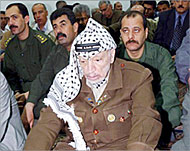Discipline and daring, trademarks of Fatah
Together Yasser Arafat and Fatah embody the Palestinian cause. It has taken years of hard work and commitment to achieve this synonymity
|
|
|
Yasser Arafat is one of the |
With his trademark kuffiyeh headdress and grey stubble, the face of Palestinian Authority President Yasser is probably among the best-recognised in the world. To all intents and purposes it is also the brand image of the Palestinian struggle.
The brand is not without substance. Arafat’s power and authority stems from his position in the organisation he helped found – Al-Fatah, a reverse acronym of the Arabic, Harakat at-Tahrir al-Wataniyyeh al-Falastiniyyeh.
Formed in the late 1950’s by Arafat along with some of his close friends, Fatah was, to begin with, at loggerheads with the Palestine Liberation Organisation (PLO) that was backed by larger Arab nations like Egypt, Syria and Jordan. For almost 10 years, Fatah functioned independently with Syrian support. In 1965, Fatah, whose emblem is a grenade and crossed rifles superimposed on the map of present-day Israel, started raiding Zionist targets.
Over time Fatah and the PLO drew closer in their battle against Israeli occupation. It came as no surprise when in 1969 Arafat took over as chairman of the executive committee of the PLO. It was also the PLO’s implicit recognition of Fatah’s ability. In 1969 alone, according to one estimate, the organisation carried out 2432 attacks on Israeli targets. Fatah had come of age.
For the uninitiated, Fatah and the PLO appear indistinguishable, such is the dominance of Fatah. One key reason for this is attributed to the discipline and commitment of the group, right from its inception.
 |
|
Marwan Barghouti, currently in an Israeli |
In 1993 under the Oslo peace agreement the PLO led by Arafat renounced “terrorism” – Israel’s blanket description of resistance acts – and accepted Israel’s right to exist. Israel in turn recognised the PLO as the legitimate representative of the Palestinians. It was to be the start of a long-awaited peace process. But the road map for peace has not exactly gone the way Palestinians envisaged. It has derailed, and the Palestinians are once again back in the thick of an uprising against Israeli occupation.
Fatah’s hands may appear to be tied in the uprising against Israeli occupation as it holds a key place in the administration of areas controlled by the Palestinian Authority. But this has not happened. The Al-Aqsa Brigades and Fatah’s Tanzim have taken over where the main body of Fatah left off.
The Tanzim is the armed wing of the Al-Fatah, and serves several purposes. Firstly, it ensures that Fatah does not lose its grip in the struggle against Israel. Secondly, as a secular nationalist group, it counter-balances the Islamist groups Hamas and Islamic Jihad. Thirdly, it has the capability to take on the Israeli security forces and armed Jewish settlers without compromising any agreement that the Palestinian Authority may have signed with Israel.
Simultaneously, the Al-Aqsa Martyrs’ Brigade too has emerged as a formidable force. More radical than the Tanzim, Al-Aqsa is also said to be affiliated to Arafat and his Al-Fatah. Al-Aqsa has sent its volunteers for human bombings and is again a countervailing force to the Islamists of Hamas and Palestinian Islamic Jihad.
The United States and Israel have tried hard to trace the intricate network that is said to link Arafat and the two fighter wings. But Al-Fatah carries on unfazed – governing the areas under Palestinian control even as a younger generation of Palestinians takes on the responsibility of resisting Israeli occupation.
